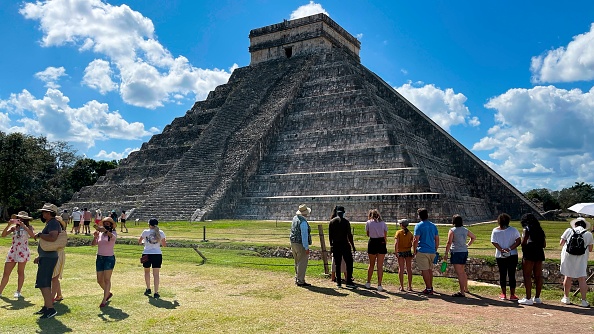Latin America
Related: About this forumLidar reveals pre-Hispanic low-density urbanism in the Bolivian Amazon
Published: 25 May 2022
Heiko Prümers, Carla Jaimes Betancourt, José Iriarte, Mark Robinson & Martin Schaich
Abstract
Archaeological remains of agrarian-based, low-density urbananism1,2,3 have been reported to exist beneath the tropical forests of Southeast Asia, Sri Lanka and Central America4,5,6. However, beyond some large interconnected settlements in southern Amazonia7,8,9, there has been no such evidence for pre-Hispanic Amazonia. Here we present lidar data of sites belonging to the Casarabe culture (around AD 500 to AD 1400)10,11,12,13 in the Llanos de Mojos savannah–forest mosaic, southwest Amazonia, revealing the presence of two remarkably large sites (147 ha and 315 ha) in a dense four-tiered settlement system. The Casarabe culture area, as far as known today, spans approximately 4,500 km2, with one of the large settlement sites controlling an area of approximately 500 km2. The civic-ceremonial architecture of these large settlement sites includes stepped platforms, on top of which lie U-shaped structures, rectangular platform mounds and conical pyramids (which are up to 22 m tall). The large settlement sites are surrounded by ranked concentric polygonal banks and represent central nodes that are connected to lower-ranked sites by straight, raised causeways that stretch over several kilometres. Massive water-management infrastructure, composed of canals and reservoirs, complete the settlement system in an anthropogenically modified landscape. Our results indicate that the Casarabe-culture settlement pattern represents a type of tropical low-density urbanism that has not previously been described in Amazonia.
Main
During the Late Holocene epoch, pre-Hispanic agriculturalists in the Llanos de Mojos, Bolivia, transformed the most-extensive, seasonally flooded, Amazonian savannahs (120,000 km2—roughly the size of England) into productive agricultural and aquacultural landscapes with an apparent diversity in sociopolitical organization, water-control systems and economic bases14,15,16,17. The southeast sector of the Llanos de Mojos (our study region) benefits from soils that have advantageous agricultural properties because of the deposition of a mid-Holocene sedimentary lobe that creates a slightly more elevated topography than the surrounding Llanos de Mojos, which in turn, provides base-rich, Andean-derived, well-drained soils18. The Casarabe culture developed here between around AD 500 and AD 1400, spreading over an area of 4,500 km2 (see ‘Chronology’ in the Supplementary Information, Supplementary Figs. 3–5 and Supplementary Tables 2–4). Previous remote-sensing and field-reconnaissance analyses have revealed the presence of 189 large monumental sites (locally known as ‘lomas’), 273 smaller sites and 957 km of canals and causeways10,19 (Supplementary Table 1). Excavations and bioarchaeology indicate that monumental sites were not unoccupied ceremonial centres but inhabited throughout the year by agriculturalists who cultivated a diversity of crops, with maize (Zea mays) as the primary staple10,11,12,20,21, and who met their protein needs by hunting22 and fishing23.
Despite these important advances in the archaeology of the Casarabe culture, until now, we knew the extent and details of mounded architecture only from less than a handful of isolated sites (Extended Data Figs. 5a, 7) because of the logistical difficulties of mapping sites in tropical forested settings. As a result, our understanding of the civic-ceremonial architecture of the major sites and the regional organization of the Casarabe-culture settlements has remained poorly understood. To remedy this situation, we conducted airborne laser mapping for six areas (10–85 km2) that have known concentrations of major settlements, totalling 204 km2 (Fig. 1).
Lidar (light detection and ranging) documented in detail the two large settlement sites and 24 smaller sites, of which only 15 were previously known to exist. The new data allowed us to define a four-tiered hierarchy classification of sites (Supplementary Table 5) on the basis of (1) the dimensions of human-made base platforms; (2) the elaboration of the civic-ceremonial architecture on top of them; (3) the presence, number and total area enclosed by the outermost polygonal enclosures (Figs. 2, 3 and Extended Data Figs. 1–4); (4) the number of constructed, straight causeways leading to the site (Fig. 3); and (5) the scale of investment in water-management infrastructure, including systems of canals and water reservoirs (see Supplementary Information for a detailed description of the architectural elements and a description of representative sites).
More:
https://www.nature.com/articles/s41586-022-04780-4
Also posted in Anthropology:
https://www.democraticunderground.com/12298080
Judi Lynn
(160,644 posts)By Paw Mozter May 26, 2022 03:06 AM EDT
Several hundred communities dating from 500 to 1400 AD have long captivated archaeologists in Bolivia's Llanos de Mojos grassland. Researchers have now visualized the proportions of the biggest known Casarabe culture hamlet.
LIDAR mapping suggested that it is early urbanization with a high population density, which is the only known occurrence so far from the Amazon lowlands. The findings gave fresh information on how widespread and diversified early urban life was throughout the world, as well as how ancient cultures lived in the Amazon.
Pre-Hispanic cities in the past

(Photo : DANIEL SLIM/AFP via Getty Images)
Dr. Heiko Prümers of the German Archaeological Institute and Prof. Dr. Carla Jaimes Betancourt of the University of Bonn, who was a student in La Paz at the time, began archaeological investigations on two "mounds" near the community of Casarabe in Bolivia more than 20 years ago.
The Mojos Plains is located on the Amazon's southern rim. Even though the savannah plain, which floods several months a year during the rainy season, discourages permanent habitation, there are numerous apparent relics of the time before Spanish colonization in the early 16th century.
In addition to the "mounds," these traces mostly consisted of causeways and canals that frequently run in a dead straight line through the savannahs for kilometers.
More:
https://www.natureworldnews.com/articles/51019/20220526/archaeologists-use-lidar-laser-technology-uncover-pre-hispanic-towns-bolivia.htm